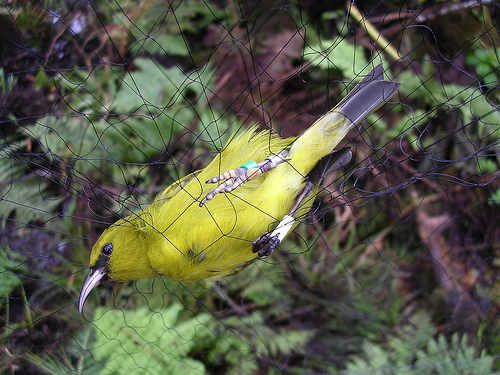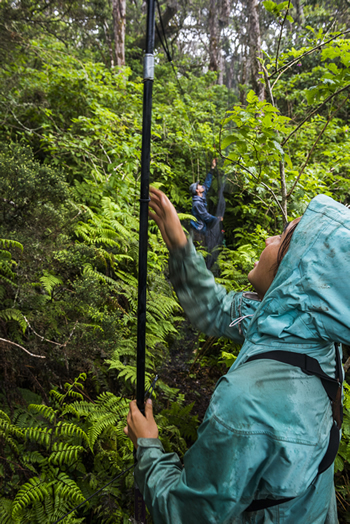Population Monitoring
Assessing DemographicsPOPULATION MONITORING
Mist-netting and Banding
Our team employs a variety of field techniques in order to identify and monitor birds in the wild. One of these techniques is mist-netting and banding. The capture of birds in the wild provides biologists with insight into the health and demographics of the bird species being studied.
“Invisible” mist-nets (so-called because they are as difficult to see as mist) are erected in the forest to capture the birds. Birds are caught either passively or by using playback of their calls to attract them to the net. When the birds are caught in the net, they are carefully extracted and banded quickly and efficiently by trained biologists.
Individuals are each fitted with an aluminum band with a unique numerical combination issued by the U.S. Geological Survey. Data are collected on the bird’s health, reproductive status, age, and morphological measurements. From this information, we are able to monitor population changes and individual fitness. These bands have been developed to fit around the birds’ leg like a solid bracelet and do not affect the birds’ lives or mobility in any way after they are released.
Key species are also fitted with an individual combination of three colored plastic bands. Color-banding individuals allows for field identification without recapturing the bird. We use binoculars to view the birds from a far and read the color combination. This is called a re-sight. These re-sights over time help us collect data on survival estimates for individuals, create maps of territories, find nests and pairs, and have more accurate life history information. This is of particular importance in small populations so that we can estimate population size and reproductive success of individual pairs.
Nest and Fledgling Searching
Finding nests and fledglings helps determine a population’s breeding or reproductive success. Our team has spent countless hours trying to find Kiwikiu pairs, their nests, and young. When nests are found, we monitor them to determine their fate (success or failure). If they fail, we try to understand why that happened. This allows us to better understand the limiting factors of the population. What is preventing them from breeding successfully and how can we improve their odds of reproducing? Reproduction is key to stabilizing and growing a population. From finding nests, juveniles, and pairs, we determine the proportion of the Kiwikiu population that are reproducing successfully. This allows us to better understand the Kiwikiu population, so that we can better manage their populations to increase their breeding success and survival.
View Publications page for papers about this research. See Using GIS for an example map of Kiwikiu home ranges.


Save the Forest, Save the Birds
It takes a community of dedicated individuals and support to make conservation happen
